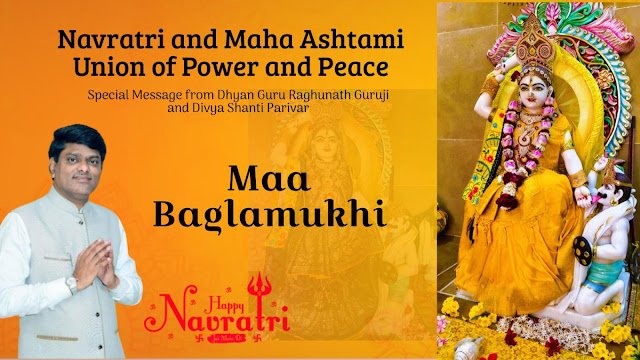Pune, September
2025 : The morning ambience, fragrance of incense and lamps in the temple
courtyard, the echo of mantras, and the devotees’ concentrated prayers — this
was the scene at the Navratri Sadhana organized by Divya Shanti Parivar. With
flowers in hand, barley sprouts and a sacred pot before them, and the sound of
Om chanting filling the atmosphere — the entire campus seemed immersed in power
and peace.
Spiritual
Importance of Navratri
Dhyan Guru
Raghunath Guruji addressed the devotees and said, “Navratri is not just a
festival, it is a period of self-purification and inner strength. Each day we
worship a different form of the Goddess, and each form bestows a unique power
and virtue upon us. Even Lord Rama performed this sadhana before the battle
with Ravana to invoke divine strength.”
Barley Sprouting
and the Environment
During
Ghatasthapana, when barley seeds are sown as part of the Navratri rituals,
their sprouting is not only a sacred tradition but also a symbolic way of
reading nature’s signs. Culturally, people observe the color and growth of the
barley to predict agricultural and environmental conditions.
If the sprouts grow
tall and green, it is believed to signify favorable weather ahead — a promise
of good rainfall, fertile soil, and an abundant harvest. On the other hand, if
the sprouts appear yellowish or stunted, it is taken as an omen of imbalance in
seasonal patterns, hinting at irregular rainfall or agricultural challenges.
This ancient
observation reflects the deep bond between rituals and ecological awareness in
Indian traditions. Long before modern meteorology, communities turned to such
natural indicators to connect spiritual practice with environmental balance,
blending faith, agriculture, and sustainability into one holistic worldview.
Maha Ashtami:
The Pinnacle of Sadhana
The most
significant day of Navratri is Maha Ashtami. From early morning, temples were
filled with devotees. Some places witnessed Kanya Pujan while others prepared
for havan.
Guruji explained,
“On Ashtami, divine power reaches its peak. Worship of Goddess Kaalratri and
Mahagauri removes ignorance and fear, and ushers in purity and peace. A
collective ‘Om Havan’ fills the atmosphere with positivity.”
Moon and Balance
of Ashtami
From Full Moon
(Purnima) to Ashtami, the moon gradually decreases in size. The flow of light
and energy also changes, which can subtly affect sleep, mood, and mental state.
On Ashtami, the
moon is about 50% illuminated and 50% dark — symbolizing balance. This state
brings a harmonizing effect on both mind and body.
As the moon wanes
further towards Amavasya (New Moon), darkness increases, often influencing
sleep and mood with a deeper, quieter effect.
Scientific
Significance of Ashtami – 7 Positive Aspects
(Dhyan Guru
Raghunath Guruji – Divya Shanti Parivar)
Moon’s Balance (50%
illumination): On Ashtami, the half-moon symbolizes balance between light and darkness,
naturally stabilizing the mind for meditation and sadhana.
Full
Moon–Ashtami–New Moon Cycle: The waxing and waning of the moon can affect sleep
and mood. Ashtami, being a middle stage, is seen as a balanced phase — a
hypothesis worth scientific exploration.
Mental Calmness: Research shows lunar cycles can subtly influence mood. Ashtami
provides a balanced state — neither overly stimulating nor overly lethargic.
Benefits of Om
Chanting: Studies (HRV, fMRI) link chanting Om with
reduced stress and better nervous system balance. On Ashtami, its effects feel
even deeper.
Environmental
Benefits of Havan: Medicinal offerings in a havan
purify the air and reduce microbial load, creating a positive vibration in the
environment.
Union of
Energies: On Ashtami, the coolness of the moon and the
warmth of the sacred fire come together, harmonizing body, mind, and
consciousness.
Ideal Time for
Sadhana: Meditation and chanting on Ashtami are
considered more receptive, as cosmic balance and purified surroundings give the
practitioner a profound experience.
Power and Peace
in Harmony
The symbolic union
of the fire’s warmth and the moon’s coolness is the essence of Maha Ashtami.
Guruji said, “Power alone is not enough. The purpose of power is to bring
compassion and peace. That is the real meaning of Maha Ashtami sadhana.”
Social Message
During the
collective aarti, men, women, and children all prayed to Goddess Durga
together. Guruji said, “The Divine Mother is not just for one family, but for
the whole universe. Worshiping her is meant for the welfare of all humanity.”
Conclusion
The festival of
Navratri and Maha Ashtami reminds us that life requires both power and peace in
balance.
Divya Shanti
Parivar resolved that through collective sadhana and positive energy, not only
individuals but families, society, and the entire world may benefit.
Maa Baglamukhi – Sattvic Legends, Ancient History, and Appearance
Appearance in
Saurashtra: According to ancient traditions, Maa Baglamukhi first appeared in
the Saurashtra region. On Mount Girnar and nearby sacred grounds, sages and
deities worshipped her with sattvic devotion.
Legend of Satya
Yuga: During Satya Yuga, when a devastating storm and
cosmic calamity struck, Lord Vishnu performed severe penance at Haridra
Sarovar. Maa Baglamukhi manifested and stopped the destructive storm, saving
creation.
Control of Demon
Dantavakra’s Speech: A demon named Dantavakra
tormented gods and righteousness by speaking falsehoods. Maa Baglamukhi caught
hold of his tongue, silencing falsehood and establishing truth — symbolizing
that the Goddess herself protects truth.
Sattvic Form and
Significance
Power of
Compassion and Peace: Maa Baglamukhi is also called
Peetambara Devi. The yellow attire symbolizes peace, compassion, and sattvic
purity.
World Peace and
Welfare: In Girnar and Saurashtra, her worship was
associated with global peace, public welfare, and mental tranquility.
Crisis
Protection: She is invoked as the power who protects
against storms and natural disasters.
Happiness,
Peace, and Prosperity: Her worship brings balance,
mental stability, and family harmony.
Healing and
Relief from Suffering: Maa Baglamukhi removes inner
enemies like disease, unrest, or grief, granting health and contentment.
Establishment of
Truth: She directs speech and thought towards truth,
fostering justice, righteousness, and love in society.
Tradition of
Shrines: Later, she became worshipped as Peetambara
Shakti in Nalkheda (Madhya Pradesh), Datia, and Kangra (Himachal Pradesh),
where her Shakti Peethas remain famous today.




